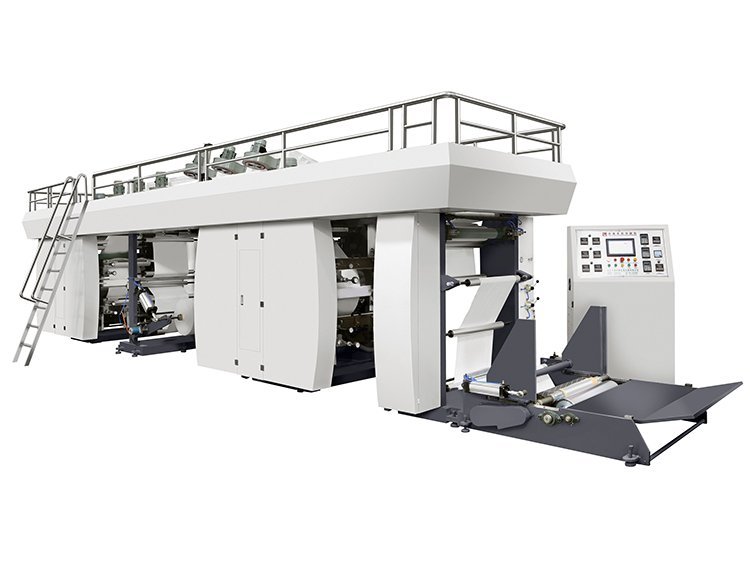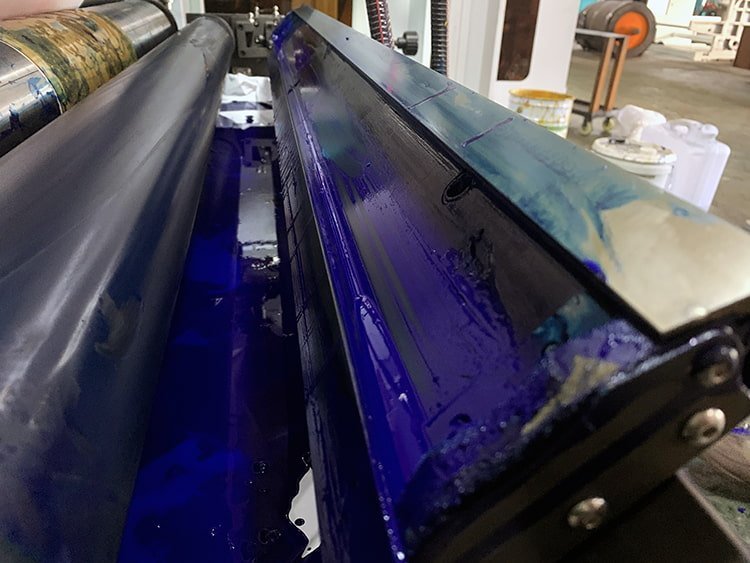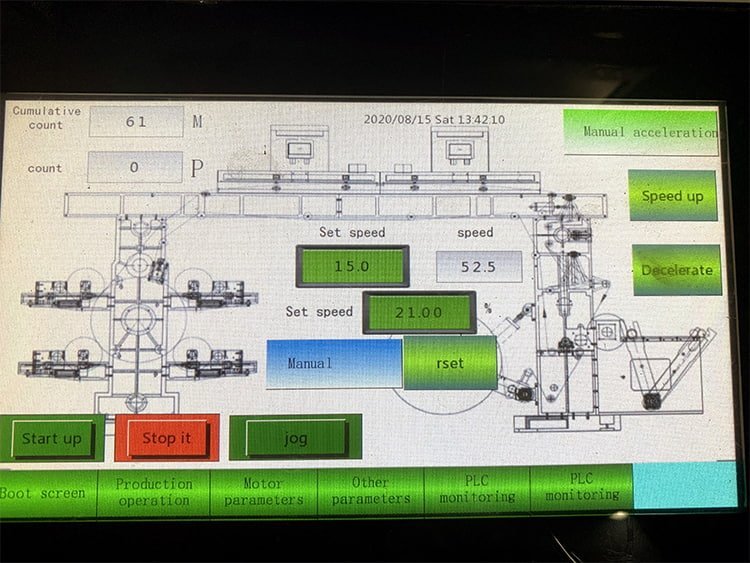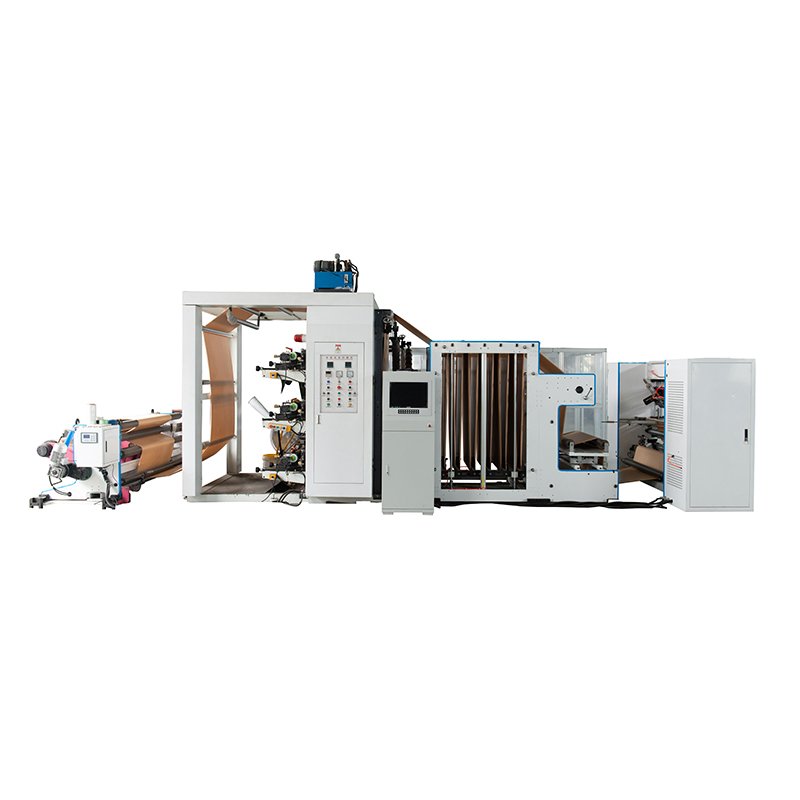JT-41000 CI Flexo Printing Press
- Big Central Impression Cylinder
- Printing Precision Tolerance 0.005mm
- Max. Printing Speed 250m/min
- Max. Printing Width 960mm
- Specification
- Video
| Item | JT-41000 CI flexo printing press |
| Colors | 4/6/8 |
| Web Width | 1000mm |
| Max. Printing Width | 960mm |
| Printing Length | 300-1000mm |
| Max. Printing Speed | 250m/min |
| Anilox Roller | 300LPI-1000LPI |
| Precision | ±0.005mm (horizontal); ±0.005mm (longitudinal) |
| Total Weight | 11000Kg |
| Overall Dimensions (L x W x H) | 12100mm x 4300mm x 5500mm |
JT-41000 CI Flexo Press
Last Update Time:23/03/2022
Eric Bernard is from Quebec, Canada bought one set JT-41000 CI Flexo Press and has been engaged in the small thermal paper rolls business for almost 20 years. Since the start of cooperation in 2012, Eric Bernard has purchased four machines from our Jota:
A CI flexo printing press, a JT-JTH-4100 4 colors thermal paper flexo printing machine, a JT-SLT-900A thermal paper slitting rewinding machine, and a JT-SLT-900 thermal roll slitting machine.
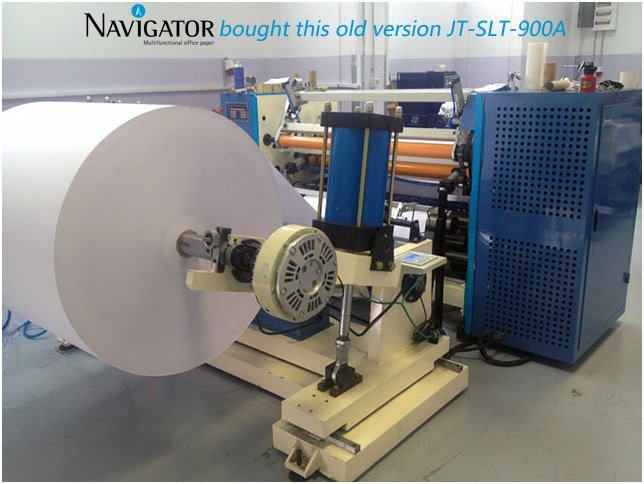
The first thermal roll-making machine used by Eric Bernard was a thermal paper slitting machine made in the United States.
Over the past 20 years, Eric Bernard’s thermal paper business has continued to grow, and Eric Bernard’s customers have increasingly demanded thermal paper printing.
So in 2012, after repeated inspections, Eric purchased a 1400mm wide JTH-4100 four-color flexographic printing press from us.

JT-JTH-4100 Thermal Paper Flexo Printing Machin
Because in North America, the max. thermal paper jumbo roll width is 54″ (1371.6mm), and the minimum unwinding width of the printing press is 1400mm.

On the basis of the original machine, we made a series of improvements for Eric, including the unwinding width, the master motor power, the unwinding and rewinding motor power, and the enhancement of some corresponding mechanical parts.
Thermal paper printing has higher requirements for temperature control than conventional film printing because thermal paper is very sensitive to temperature changes. If the temperature is too high, the thermal paper will turn black and waste materials.
Therefore, our technical team made special improvements to the drying tunnel of the printing press and equipped the machine with a more precise temperature controller.
With the further development of Eric Bernard’s business, the previous JTH-4100 flexo printing machine can no longer meet the demand for production.
In 2019, Eric decided to buy another printing press. This time, it happened that our flexo printing machine was released.

We recommended our 4-color 1400mm central impression flexographic printing machine, with hydraulic loading jumbo roll unwind stand, surface winding, automatic tension control, and online printing quality monitoring system.

Hydraulic Jumbo Roll Loading Unwind Stand
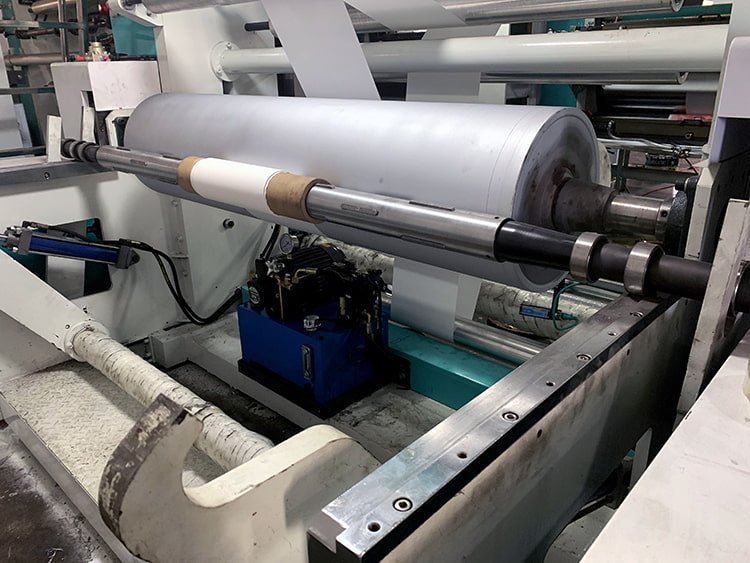
Surface Winding

Online Printing Quality Monitoring System
CI flexographic printing presses introduce a big drum central impression roller in the middle as an impression cylinder.

Big Drum Central Impression Cylinder
Different printing decks share this big drum central impression cylinder, the printing accuracy will be higher, and the machine running speed will be more stable.
The machine adopts ceramic anilox roller 300-1000LPI, with an enclosed chamber doctor blade, the highest precision is 0.005mm, and the highest working speed can reach 250m/min.
With the automatic registration device, the operation is much easier.
So far, we can provide 4, 6, and 8 color CI flexographic printing presses. Following materials include be supported:
| Paper | Kraft paper: 40-350gsm; Single side coated paper: 30-350gsm; Office copy paper: 15-350gsm; Fireworks paper: 40-350gsm; Silicone paper: 50-350gsm; Dust-free paper: 25-350gsm; Release paper: 40-350gsm; Composite paper: 30-350gsm. |
| Fabric | Woven: 15-120gsm; Weave fabric: 15-500gsm; Non woven: 15-150gsm. |
| Film | PVC: 10-120gsm; OPP: 10-120gsm; PE: 10-120gsm; PET: 10-120gsm; CPP: 10-120gsm. |
CI Flexo Printing Machine FAQ Guide
Today, the world has reached considerable heights in the manufacturing and printing industry. Every industrialist is chasing behind the effective marketing schemes which benefit their product sale.
Printing is one of the clients grabbing tools that you can adopt. For this purpose, flexo printing or Central Impression flexo printing machines are used.
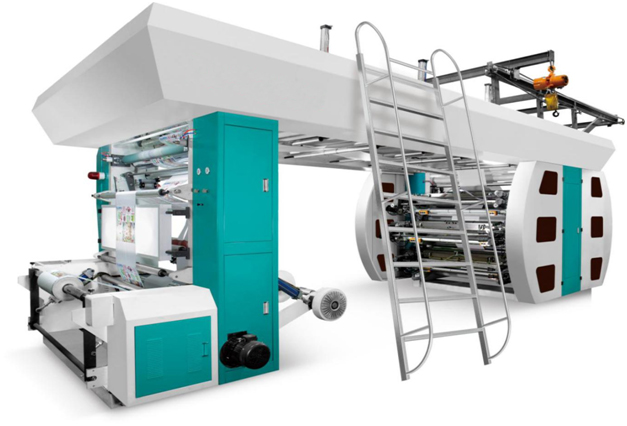
If you are thinking to establish a business, you must think about going for the printing press. It is a valuable machine to invest in.
Jota Machinery is one of the leading manufacturing industries which keeps in touch with the trending machines. You can also contact Jota for further clarifications about the CI flexo printing machine.
Let me unravel to you the essential features of this flexo printing press to make it easier for you to invest in this business.
- CI Flexo Printing Machine – An Introduction
- Working Process of CI Flexography Printing Machine
- What Is Exemplary about Jota CI Flexo Printing Machine
- Raw Material Needed for Printing
- Types of C1 Flexo Printing Machine
- Perks Attached to Jota’s CI Flexo Printing Press
- Why Printing Is Necessary?
- Applications of CI Flexo Printing Machine
- Is It Fully Automatic?
- Get Customized CI Flexo Printing Machine
- Are Printed Papers Recyclable?
- Difference between Offset and Flexo Printing
- Things You Need to Know about Flexo Printing and Digital Printing
- Is Flexographic Printing Expensive?
- Ways to Identify CI Flexo Printing Machine
- Does Flexo Printing Cause Ghosting?
- Label Printing with CI Flexo Printing Machine
- Best Manufacturer around You
- Price CI Flexo Printing Machine
- Jota’s After-Sale Services
CI Flexo Printing Machine – An Introduction
First of all, you need to learn what a CI flexo printing machine is?
Flexo printing machines are machines that use a flexible relief plate to transfer ink to the printed substrate. Each printing job will necessitate its own set of plates.
As a counter impression roll, flexo CI presses employ a central drum that is shared by all colors. Flexo presses can print on a variety of substrates, including plastic films, paper, and aluminium foil.
CI (Central Impression) flexo printing machines are particularly well suited to markets that demand process workloads and flexibility (involve productions of small lots).
In particular, technical advancements over the last 15 years have reshaped flexo printing presses, both mechanically and in terms of their controls.
As a result, their printing quality increased, changeover times were dramatically decreased, and their “minimum economical lot” was reduced.

CI printing is different than traditional printing. Traditional printing is a printing technique that involves transferring ink from aluminum plates to a rubber sheet (sometimes known as a “blanket”).
After that, the picture is rolled out onto the printing area.
When printing huge volumes, this approach is often regarded as the best solution. Although the initial cost of setting up the equipment is costly, new units become less expensive as the quantity grows.
Working Process of CI Flexography Printing Machine
A step-by-step working process of the printing machine is here for you. Make sure to read with full attention, as it will develop your knowledge about the product you are about to buy.
Printing Plates
Jota uses photopolymer printing plates with a mirror relief picture of the necessary print in printing machines.
The plate is one of the flexo press’s unique features. It transfers the printing design to a flexo plate.
Stamps or letterpress are examples of similar concepts.
The relief on the flexo plate picks up the ink from the anilox as it rotates on the plate cylinder or sleeve, then transfers it to the substrate or printed materials.
Photopolymers are used to make the flexo plates. The plate design is exposed utilizing CTP (computer to plate) technology during the production process.
On the flexo plate, the exposure design creates a relief image. Plate screening is a standard method of structuring the relief to make the image.

Anilox Roller
An anilox roller applies ink to the elevated portions of the plate. Then it transfers to the substrate.
An anilox roller is a highly developed metal or ceramic cylinder laser. It is engraved with minute cells of a specific angle, line screen, and volume to achieve the needed print fineness.
- The CI flexo press’s anilox is the cylinder or cylinder sleeve that scoops up the ink for printing.
- If we examine the anilox closely under a microscope, we can see that it comprises millions of microscopic cells that pick up the ink.
- Ink is picked up in different ways by different cell shapes. Hexagons at various angles, quadrangles, lines, and canals are the most common cell shapes.
- The cell’s depth is also available in multiple forms, including a sharp pyramid, flattened pyramid, and a straight cut.
- The size of the cells can also be specified in terms of LPI (line per inch), with more lines indicating more cells on the anilox.
- More cells can be put onto the anilox as the cells get smaller. It enables the pickup of more delicate layers of ink, but it also means that anilox will pick up less ink because the cell holes are smaller.
- BCM, or billion cubic microns per square inch, is the unit of measurement for the volume of ink picked up by each cell.
- There must be a balance between the LPI and the BCM when selecting an anilox suited for the printing job.
- The LPI and BCM have an inverse connection, indicating that the higher the LPI, the lower the BCM, and vice versa.
Plate Cylinder
It is a section on which the printing plate is mounted.

Chambered Doctor Blade System
It is a device that provides a measured amount of ink to the cells of the anilox roller.
Impression Cylinder
A sleeve that supports the substrate while the printing plate is pressed against it is known as an impression cylinder.
Inking system
Ink storage tank, ink pump with delivery and return ink lines, and additional components to ensure ink supply and viscosity are maintained.
Flexo ink for flexo presses is generally available in three basic types: water-based, solvent-based, and UV / UV-LED curing ink.
The flexo inks must dry quickly to match the mechanical speed of the flexo press, which is typically between 250 and 500 meters per minute.
For the best print results, flexo ink must be maintained and managed at a specific viscosity, pH, and temperature range during the printing process.
It’s a complex and time-consuming operation to keep the ink in a regulated state. As a result, many flexo printing press manufacturers include an automatic ink control system in their machines.

Driers
Jota engineers insert driers between the print units. The purpose is to prevent overlapping while applying the following colors.
Depending on the application, these driers may use hot air, infrared, or ultra-violet light.
The ink is pumped into the ink chamber of the doctor blade system during the printing process. The barrier blade and the doctor blade seal each end of the ink chamber and restrict the ink to the section when it is in contact with the anilox roller.
The cells in touch with the doctor blade system collect ink as the anilox roller rotates, and any surface surplus is eliminated when the roller passes beneath the doctor blade.
The ink is transferred when the anilox’s surface touches the raised portions of the printing plates mounted on the plate cylinder as it revolves.
The printing plate then rotates to transfer the picture subsequently to the substrate.
In this way, the flexo printing machine prints the specific material.
You can further watch the video down below to grasp the idea of the working process fully.
After having the basic description about the CI flexo printing press, having a little light on the specifications would be valuable.
In the next section, you’ll learn about the specifications or parameters of the CI flexo printing machine.
What Is Exemplary about Jota CI Flexo Printing Machine
After the technical specifications, let’s see what makes the Jota CI flexo printing machine stand out.
Environment Friendly
The Jota CI flexo printing press is eco-friendly. Due to the increased global warming and environmental hazards, every manufacturing industry’s prime goal is to build products that do not cause harm to the climate.
With all the good fortune, Jota can manufacture the climate-hazard free flexo printing machine.
The material which the CI flexo printing press uses is consumable and does not stay for years in the environment.
No waste
Jota’s printing machine does not waste any material during the printing process.
It is wisely designed not to create any extra waste that increases the cost.
Food Safety
The ink used in Jota’s printing machine is by no means harmful to the food. There are no harsh chemicals that affect the quality of the product. Instead, the Jota CI flexo printing machine retains the quality of the products.
Let us move towards the Raw material now.
Raw Material Needed for Printing
The printing press is capable of printing on a variety of substrates and materials.
Porous substrates such as paper, cartons, and cardboard are some printable examples. PE, PET, PP, and aluminum are examples of non-porous substrates.
The unwinder unit feeds the substrate into the flexo press in a roll form. You must precisely control the substrate’s tension as it passes through the printing and drying equipment.
In terms of print quality, the ability to maintain a precise substrate tension makes all the difference. It is a critical distinction between a good flexo press and a lousy flexo press.
Paper is a fiber-based material made from wood, rags, or other organic materials.
Wood and/or recycled paper and board are frequently utilized in packaging and graphic arts paper, which is then chemically or physically treated to produce cellulose pulp.
This pulp is bleached and processed in a paper-producing machine, resulting in paper reels coated or polished for a better surface and/or improved visual appearance.
Types of Satellite Type CI Flexo Printing Machine
Based on the working and features of the CI flexo printing machine, there are three main types.
These types are as below.
CI Flexo Press
The impression method of the CI flexo press is one of its distinguishing features.
The CI central drum is a large circular drum in the printing decks’ center.
Each printing deck surrounds the CI, and each printing plate exerts its print pressure against the CI center drum. During the printing process, you must place the substrate on top of the CI central drum.
This design feature allows the CI flexo printing press to maintain a tighter registration and better control of substrate tension. As a result, superior print quality and more incredible printing speed are possible.
Inline Flexo Press
You can combine flexo printing with other inline processes to experience increased efficiency.
For example, you can integrate extrusion, coating, lamination, die-cutting, embossing, slitting, sheeting, and bag production.
This inline application is used to manufacture items that do not require the highest printing speed and require less precise print registration.
The print quality criteria, on the other hand, is not very high. The fast-food sector, which includes McDonald’s, Burger King, and KFC, is a group of inline flexo press users who print frequently.

Flexo Press Stack
Stack flexo presses are similar to CI flexo presses, except instead of a CI central drum in the center, each print deck has its impression roller.
The stack press is a more cost-effective option if the printer does not require the highest print quality at the fastest possible pace.
One of the stack flexo press advantages is that it can do both surfaces and reverse printing in one pass because each deck has its own set of impression rollers.
Each type of flexo machine has its configuration. This physical difference frequently affects the location and application for which a press is best suited.
A CI press has only one impression cylinder or drum, and the print stations are arranged around it. Individual print stations are progressively placed one after the other along a web path in an inline press. A stack press has print stations or print decks stacked one on top of the other vertically.

Perks Attached to Jota’s CI Flexo Printing Press
The flexo printing press has many benefits, not the least of which is that the most commonly used inks are water-based, making them easier to deal with and drying faster.
- The technique of making flexo printing plates is quite simple, and it may be quickly adapted to a variety of substrates.
- The high print quality and registration precision of CI (Central Impression) flexo printing are widely known. The recent advancements in in-line flexo printing presses have allowed flexographic presses to compete against gravure and lithographic machines in industries like fiber-board packaging manufacturing.
- Compared to gravure and offset printing, flexo presses, particularly CI flexography printing presses, can run at exceptionally high speeds.
- Flexo presses are capable of printing on a wide range of substrates.
- When compared to gravure, the flexo press requires less setup time, resulting in less waste.
- A flexo press uses water-based ink or UV/UV ink.
- LED inks are far more environmentally friendly than gravure inks.
- Flexo presses are excellent for medium to long-run tasks.
After knowing these benefits, contact Jota right away if you are thinking about starting your own CI flexography printing machine business!

Why Printing Is Necessary?
It is a fundamental question to understand.
Let us evaluate why printing is necessary?
Branding
An essential function of printing nowadays is branding.
Branding is to promote your company name with the help of printing techniques.
You can draw labels or print your company logo onto the products.
It helps in marketing, and people are powerfully attracted to your brand.
Profit
After branding, more clients visit your firm, which ultimately adds to the company profit and fast ROI.

Applications of CI Flexo Printing Machine
There is a wide range of applications of the CI Flexo printing machine.
It has a:
- Flexible and aluminum packaging. It does not restrict to the use of paper only.
- Pre-print liners and labels, which is a great benefit. You can pre-print the labels and then manufacture the product.
- Plastic and paper bags
- Heavy-duty paper sacks
- And shrink sleeves are all examples of CI flexography printing uses.

Is it Fully Automatic?
Yes, jota has designed the CI flexo-printing machine that is fully automatic.
This feature of the CI printing press
- Enhances the productivity
- Reduces man labor
- Less time consumption
- Less energy usage
- No waste
- Increases working hours
Moreover, with the help of a fully automatic system, the machine becomes easy to operate.
Get Customized CI Flexo Printing Machine
Jota fully gives you the liberty to customize your machine.
You can visit the jota workshop and choose the machine of your choice. Also, you can ask for custom-made designs, innovative components, and up-to-date systems.
Give Jota your demands, and wait for the time when you will see the machine of your dreams on the floor.
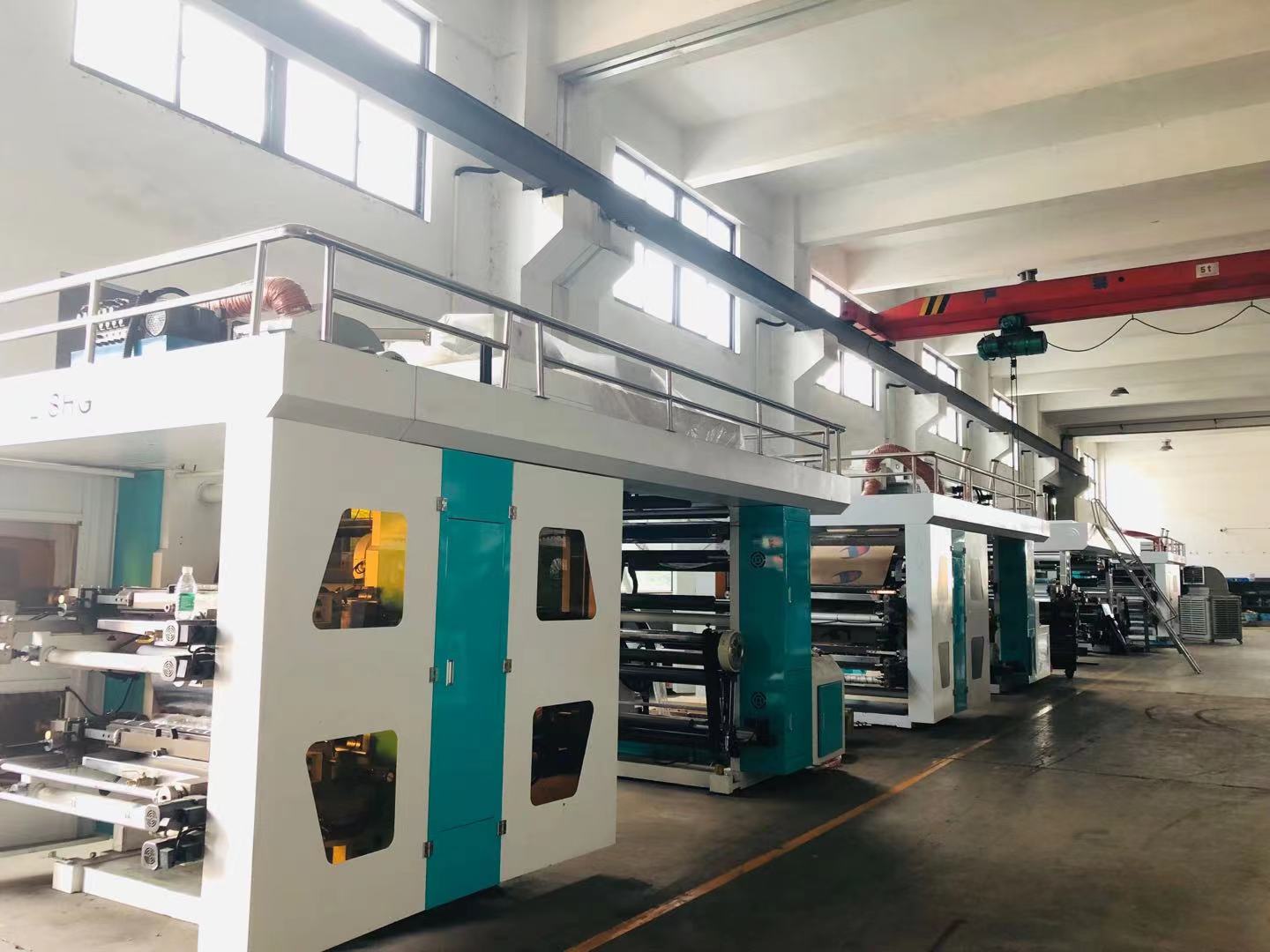
Are Printed Papers Recyclable?
Yes, the printed papers are entirely recyclable.
During the recycling process, the ink is removed. The pulp is dissolved in a chemical solution and sprayed with air bubbles. Ink adheres to the bubbles and rises to the surface of the fluid.
In this way, you may get a clean recycled paper that consumers can re-use afterward.
Difference between Offset and Flexo Printing
It is crucial to know the difference between similar printing techniques. This will make you capable of thinking that why should you choose CI flexography printing machine.
- Wet ink and printing plates are used in both procedures; however, the printing processes are substantially different.
- Offset printing is a printing process that involves transferring an image from a printing plate to an intermediate carrier and then to the printed substrate. Flexo, on the other hand, transfers ink directly from the plate to the substrate.
- Both flexo and offset printing are widespread, yet they execute jobs in distinct ways. It’s critical to grasp their functions and the differences between the two sorts of printing processes. The type of press to employ is determined by the final product’s quality and volume, as well as the substrates used.
Difference of Plates
Flexo printing is a rotary printing technology that uses flexible plates. The plates are flexible enough to wrap around a printing cylinder and are comprised of a photopolymer composite.
The relief image on the plate is fixed using a laser image-setter, and the polymer in the non-print areas is washed away in a processing unit and dissolved in a solvent or water solution. A rotating ‘anilox’ roller transfers ink from the ink well to the flexo plate.
Each color to be printed requires its own printing station and flexo plate. After that, the image is printed directly on the substrate. The printing plates are fairly durable and can be re-used numerous times before needing to be replaced if stored properly.
In offset printing, ink is conveyed to the printing plate using a succession of rollers. Depending on the type of offset press, this might be a flat-bed or rotary procedure.
Typically, the plate is constructed of aluminum. Before drying, the entire wet picture (single color or multicolor) is placed onto a ‘blanket’ and subsequently onto the substrate.
Difference of Ink
Cyan, magenta, yellow, and key are the four ‘process’ colors used in offset printing (which is black).
Every color has its own printing station. Any spot colors are created by mixing the process colors together. Water-based or UV-curable inks are available.
Although process colors are utilized in the flexo process, spot colors are usually printed on separate print stations. Spot colors can be pre-mixed or mixed in-house, according on your needs.
Water-based or UV-curable flexo inks are also available. Inks based on solvents can also be employed. UV inks allow for faster printing speeds and can be kept in the press overnight without the need to empty and clean each print station.
When the press is not in use, water-based inks must be removed to prevent ink from drying on the rollers and in the ink trays.

Things You Need to Know about Flexo Printing and Digital Printing
The conventional “flexo vs. digital printing” debate revolves around size and cost. The difference between the two is given below.
- Flexographic printing takes longer to set up, and each change in visuals (for example, flavor variations, varietals, etc.) necessitates the creation of new plates.
- Flexo presses are well-positioned to create large orders cost-effectively due to their better throughout speed. The longer the run, the quicker the initial setup and platemaking costs are recouped.
- Digital printing is a plate-free printing method that takes almost little time to set up.
- Digital printing is competitive for small-to-midsized label orders due to the elimination of setup and plate costs, while flexo is the better choice for longer runs because to its faster production speed.
- Flexo printing is enhanced by digital printing. While digital printing has improved significantly, particularly with inkjet, for most print runs, flexo is still the most cost-effective option.
- Digital printing machines in general limit productivity for CI, inline, and stack that result in speeds, data processing and print device capability, and a narrowed substrate compatibility range.
- However, owing of their greater speeds and common use in printing on film, which has been more difficult to print on utilizing digital printing technology to date.
- Flexo presses are critical components of the packaging and label supply chains, as they enable print shops to meet the demands of a wide range of market segments.
- Digital printing has a place in the short-run, variable market, but it still can’t match flexo’s capacity to produce static, longer print runs. Both technologies continue to be complementary.
Is Flexographic Printing Expensive?
The expense of the Flexographic printing depends upon the number of features you want to add.
- Multi-color printing
- Front and back printing
- Labels
- Materials used
And other such things add to the cost of flexographic printing.
Ways to Identify CI Flexo Printing Machine
After reading about the components and working of the CI flexo printing machine, you will be able to identify a good quality flexo printer by:
- Observing the main parts
- Registration marks
- Working and physical conditions
Does Flexo Printing Cause Ghosting?
The faint image formed during flexo printing that can be seen on big, solid regions is known as ghosting.
It’s mostly due to the anilox failing to recover acceptable ink densities.
Ghosting occurs when you do not overlook to the problems or issues arising in your machine while working.
Low-maintenance can also be the reason of ghosting. Make sure you develop high-maintenance habits because it ensures the good health and high productivity of your CI flexo printing machine.
Label Printing with CI Flexo Printing Machine
For small to medium production runs just like labeling, a narrow web flexo press printing machine is ideal. Jota’s 300mm narrow colored CI flexo printing press uses either water-based or UV-based ink systems on HD Flexo plates to create your heat shrink sleeve requirements.
Also, there is a special CI Flex Printer machine for the label on the cloth called nylon taffeta.
Nylon taffeta is a taffeta fabric constructed from nylon fibers that are synthetic. Nylon taffeta is particularly sturdy and helpful for outdoor applications due to its thick nature and nylon’s weather-resistant and tear-resistant characteristics.
Best Manufacturer around You
Finding the best manufacturer around you is not a piece of cake. You need to struggle a little because there are many frauds out there who can snatch your money in return of a fake product.
While looking for the best manufacturer around you make sure that:
- It has a good repute
- CE certified
- Has business license
- International Feedback
- Credible sources
- Manufactures in time
- Delivers in time
- Authentic
- Shows you the workplace
- Well-developed website
If you find all these qualities in a manufacturer, you should give it a go.
Jota is one of the best and most well-established manufacturers and suppliers of CI flexo printing machines. Further, you can contact jota on the official website.
Price CI Flexo Printing Machine
It’s difficult to estimate the original investment cost or total cost of ownership for each type of CI flexo printing press.
The configuration of each press differs depending on the final application for which it is utilized to print.
CI flexo printer costs from USD100,000 to USD500,000 whereas, stack flexo printer costs from USD15,000 – 200,000
Stack flexo presses are similar to CI flexo presses, except instead of a CI central drum in the centre, each print deck has its own impression roller.
If the printer does not require the highest print quality at the fastest possible pace, the stack press is a more cost-effective option. The capacity of the stack flexo press to accomplish both surface and reverse printing in one pass is one of its advantages.
Moreover, the CI flexo printing press price also depends upon the number of features you want to have in it.
Jota’s After-Sale Services
Jota not only provides and builds machinery but also provides support once the products are delivered to your door.
JOTA also offers a number of sales services to its clients.
After-sales service for straw wrapping machines is provided by JOTA’s skilled team of personnel. The services are detailed below.
Product Inspection
Jota Machinery provides quality control services to ensure that output increases. It can be done directly by the Jota Machinery team or by allowing access to our suppliers’ extensive knowledge and expertise.
This after-sales service can be given in a variety of ways to improve the operation of a straw wrapping machine. The term “consultancy” can be applied to a wide range of situations.
- Determining whether a straw wrapping machine is suitable for a customer’s demands.
- Advising on the efficiency of a completely automatic straw wrapping machine’s manufacturing.
- Identifying the most acceptable solutions for customer demands; recommending the essential CI flexo printing machine maintenance measures
- Quality and productivity is improved.
Updated Workforce
An empowered workforce is a highly productive workforce. As a result, you should provide your personnel with a straw paper packing machine that they can trust.
Jota Machinery offers on-site training for straw paper packaging equipment at any time. This can be done by our in-house team or with the help of one of our essential vendors.
We can tailor your straw paper packaging machine to meet the needs of your company’s various skill sets and levels.
Proper Examination
You’ll need to know that your CI flexo printing machine is in good working order at all times if you’re a business. Technology for CI flexo printing machines must be efficient, resulting in an increase in input.

For ordinary workers, however, judging whether a straw packaging machine is running properly is challenging. As a result, you’ll require professional assistance.
Jota machinery can be used to test your CI flexo printing machine. It can also analyze your needs to ensure that you acquire the best CI flexo printing equipment possible.
By bringing a straw packing machine for testing, this after-sales service is offered on-site.
Upkeeping of the Product
You’ll get on-demand access to a team of highly trained professionals that can help you with mechanical and electrical concerns.
Some of the maintenance after-sales services that the Jota Machinery support personnel may help with are as follows:
- Assist with the breakdown and repair of straw packaging machines.
- It is necessary to install and commission a straw packing machine.
- Complete the identifying and reducing parts operation.
- On-site maintenance of the straw packaging machine is required.
- JOTA can execute on-site audits and maintenance operations for the CI flexo printing machine on a regular basis as part of the preventative maintenance service.
Quick Product Transport
Jota supplies you with transportation services. Jota can assist you if you are unfamiliar with the mechanics of import.
After you’ve placed your order, sit back and wait for your machine to arrive at your doorstep.
Within 15 to 30 days, Jota will provide a paper straw wrapping machine.
So, what do you have to lose?
Jota is the most comprehensive solution for your paper straw and wrapping business. It’ll not only help you in developing a strong business, but also assist you in many ways.
In order to let you know more about we Jota company, please watch the following video for reference.
We Jota could also supply following related machines, if you are also interested in any type, please feel free to send us an inquiry:
- Hot Melt Thermoplastic CFRP CFRTP Prepreg Manufacturing Machine
- Fully Automatic Thermal Paper Roll Slitting Packing Machine
- Fully Automatic Toilet Paper Maker
- Automatic Facial Tissue Making Machine
- Plastic Film, Fabric, Aluminum Foil Slitting Rewinding Machine
- Paper Sheeter
- Paper Tube Making Machine
- Paper Drinking Straws Machine
- Label Die Cutting Machine
- Cardboard Tube Cutting Machine


